This article represents the personal views of Jeremy Grantham and may not necessarily reflect the conclusions or opinions of GMO investment teams.
Summary
- Of the challenges facing humanity 1 this century toxicity is the most underrecognized. “Toxicity” means the cumulative negative health effects from some of the hundreds of thousands of new chemicals invented since World War 2. Almost none of these new chemicals were tested for long-term safety for humans and nature. They are now poisoning us more effectively than lead in paint and gasoline once did. Toxicity is a major and totally unappreciated contributor to the accelerating population collapse that faces the developed world, and stopping toxicity is going to be necessary (though far from sufficient) to stymie that collapse.
- The most important negative action of these chemicals (used in plastics, in pesticides, and in products like shampoo or perfume) is endocrine or hormonal disruption. That is, they interfere with the body’s internal signaling and development system, which during key developmental windows, like in utero and puberty, can permanently affect our development. The vast majority of chemicals on the market have never been tested for long-term effects and they cannot now be tested on humans for ethical reasons, but animal tests and human correlation studies show that tiny quantities of some of these chemicals absorbed in utero can respectively cause lifelong weight gain, neurodevelopmental disruption, and impairment of fertility.
- The rapid rise in obesity, autism, and depression is well known. Less well-known and less discussed, probably because it is a very uncomfortable topic, is the rapid reduction in fertility, with measurable significant declines in testosterone, libido, and sperm count.
- The most famous class of these endocrine disrupting chemicals, PFAS, are known as “forever chemicals” because they take so long to break down. PFAS refers to hydrocarbons where the hydrogen atoms have been replaced by covalent fluorine, a pattern that presents naturally only in toxins, and even then, does so extremely rarely. 2 There is no reason whatsoever to assume that these chemicals are innocent until proven guilty as we currently do in the U.S.
- Toxicity is going to have some major consequences. The first, and most significant to investors in the short term (but probably least significant to the world), is that many companies that make these substances will face the wrath of massive lawsuits, severely impairing shareholders. This is already happening – consider Bayer, whose stock is down over 75% since purchasing Monsanto because its most profitable product (glyphosate) has been deemed in lawsuits to cause cancer.
- The second consequence is that toxicity is causing severe harm to the natural world. There are plenty of other reasons wild biomass is declining. But the creatures most affected by toxicity – insects and amphibians – are declining fastest. Their wild populations are estimated to be falling by 2% (insects) and 4% (amphibians) annually. With insects especially critical at the base of animal food chains, such declines could lead to a cascading, total collapse of ecosystems as we know them. Such a collapse might be on its own a threat to human survival.
- The third and most important consequence of toxicity, and our main topic, is reproductive impairment. Indeed, toxicity has become an overlooked driver of the global collapse in birth rates. Over the last 50 years, toxicity has driven average sperm counts down by more than two-thirds and testosterone levels by a similar amount. Infertility is now estimated to affect one in six couples trying to have children. Age-adjusted miscarriage rates in the U.S. are rising at 1% a year. And all surveys of sexual activity – across every country, age group, etc. – suggest a decline in average libido.
- These effects have contributed to a decline in annual global births from 142 million to 130 million over the last twelve years. Every developed country ex-Israel now has a rapidly declining baby count. Japan, leading the pack, has a current crop of 20-year-olds that is down 50% from its peak about 50 years ago.
- Of course, there are plenty of other reasons for declining birth rates. Birth control, female education, and above all, falling infant mortality all played a big part in the decline in birth rate since 1960. Since then, housing, childcare, and education have all risen in price steadily more than the average. And all human desires are culturally molded; people seeing smaller families and more childless people around them tend to want smaller families themselves. Many of these reasons form a vicious cycle in which toxicity is likely an underrated component.
- This ongoing decline in sperm count and testosterone is now so severe – over 2% per annum in recent years – that if we extrapolate current trends, most couples will be infertile in as little as 20 to 30 years. If toxicity is not arrested, it could prove to be an existential threat. It will guarantee a continued decline in births. Even now, it is contributing to a collapse of population profiles that will impair social cohesion globally.
- World population is thus likely to be far lower than the 10 billion+ currently projected by 2100. 6 or 7 billion seems far more likely, and if this trend continues further, it could be down to only 2 or 3 billion by 2200. This guarantee of falling workforces and a rapidly aging population will change everything: in the short run, clearly for the worse, as capitalism and society will surely be stressed, perhaps terminally so; in the long run, if we can withstand these stresses, quite possibly for the better.
- “For the better” because arriving at a far smaller population will be a great help in reducing toxicity and the related stress on nature, climate, resources, and agriculture. But the interaction of toxicity with global demographics and the ultimate future of humankind is also the most complicated issue I’ve ever written about, rife with confounding factors.
Part 1
Toxicity and Endocrine Disruption
Novel Chemicals Are Poisoning Us
The incredible increase in chemical output since World War 2 (see Exhibits 1 and 2) has resulted in a world that is simply toxic to life in most forms, including ours. These billions of tons a year of 350,000 different chemicals, many of which are endocrine disruptors, have begun in the last 20 years to profoundly impact our ability to have children. This new factor weighs in above and beyond the economic and social pressures that already encourage populations around the world to want fewer and fewer children.
Endocrine disruptors are foreign chemicals that interfere with the body’s hormones – that is, its internal chemical signaling system. Since the explosion of petrochemical organic chemistry after World War 2, we have produced increasing quantities of novel organic compounds that are not found in nature but that are structurally quite similar to chemicals used in our own bodies, which then can interfere with our normal operation, by blocking, overstimulating, or otherwise meddling with our hormone receptors. Exposure to endocrine disruptors, especially in early life and above all, in utero, irreversibly affects development of the most sensitive bodily systems – the brain, the reproductive system, the metabolic system, and the immune system. Known endocrine disruptors include (among others) PFAS, 3 phthalates, 4 and bisphenols 5 – all three of which are in widespread use in plastics – and many pesticides. 6 Both correlation studies in humans 7 and controlled experiments on rats 8 show that exposure to various endocrine disruptors can cause reproductive damage, immune system damage, neurodevelopmental disorders, and obesity. 9
Exhibit 1: World Annual Plastics Production
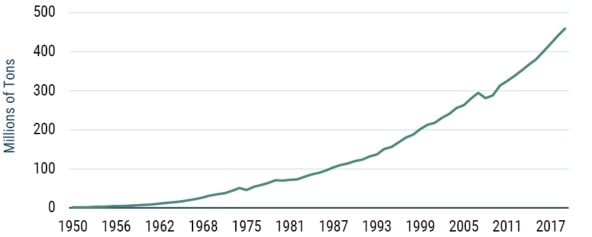
As of 2019 | Source: Our World in Data
Exhibit 2: Global Glyphosate Application, Decade Totals
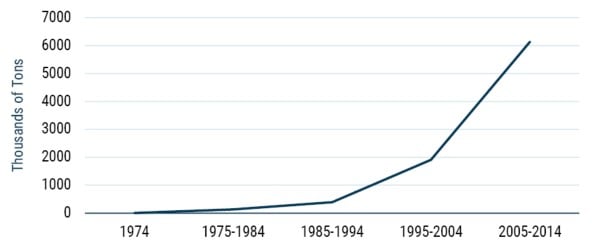
As of 1/31/2016 | Source: Benbrook
Toxicity Harms Our Fertility
The most powerful result of all this, directly affecting our fertility, is that the quantity of men’s sperm has been reduced by almost two-thirds from 1973 10 (Exhibit 3). But 1973 was already a very toxic era – sperm counts must already have been down from hunter-gatherer days. There are no good records, so we can only make intelligent guesses. (Mine would be that we must, by inference, be down by at least 75% from original levels.) The good news was that our species was hugely overdesigned in the case of sperm count, I like to say like a good Victorian bridge, and the first 40 or 45% reduction appeared to have absolutely no effect. Indeed, the growth of our global population, helped by improved medical care, peaked at over 2% annually around 1963, with over five children per woman.
Exhibit 3: Sperm Concentration Globally
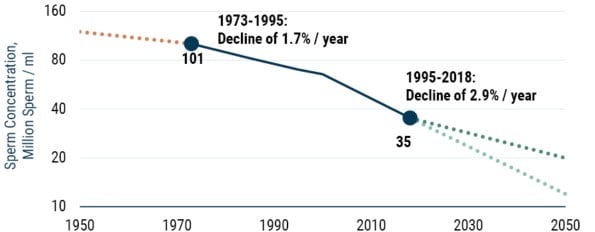
Actual Trend for 1973-2018; Projected Trend for 1950-1973 and 2018-2050
As of 11/15/2022 | Source: GMO, Levine et al.
This chronic decline in sperm count is also accompanied by rapid declines in motility (the ability to move well) and quality, which involves the number of malformations. Collectively these declines are finally starting to impact even the ability to conceive, and the proportion of couples needing help has, according to the WHO, risen to one in six. 11 What the WHO did not say, presumably because they are not looking for avoidable political fights, is that this was absolutely not the case as recently as 30 years ago. That is to say, this problem is rising very rapidly. I would be surprised if in a mere 30 years from now this one-in-six does not become a near-disastrous one-in-two or worse, for at the current rate of decline – 2.6% – sperm count will halve yet again. As Hagai Levine, co-leader of the main meta-study on sperm count, says, “It is as if we mean to go out of business.” And by “we” he means humans. He goes on to say that with falling testosterone and sperm count (and rising levels of sex-related birth defects in boys 12 ), we are becoming “less male in every way.”
Another thing to bear in mind is that sperm count in men is one of the best – possibly the single best – predictors of men’s health and longevity. 13 Thus, a rapid decline in sperm count is associated with dire consequences for general wellness and society’s healthcare costs. And men are only half the problem. Female contributions to fertility are also being hurt in many ways by the chemical onslaught. Studies show a steady age-adjusted increase in the rate of miscarriages of around 1% a year. 14 Additionally, women’s fecundity begins to drop rapidly after age 30 or so, which is now not far from the time most women in the developed world start thinking about babies. The average age for first birth is now 28 in the U.S. and 30 in Europe. 15
We Are Even Losing Our Interest in Sex!
On top of reducing sperm counts and increasing miscarriage rates, widespread and rapidly increasing endocrine disruptors have been reducing our interest in sex. This is reflected in a steady decline in measured testosterone. 16 And every study across the world is measuring a rapid decline in sexual activity in all age groups. In Japan, for example, in a rare peer-reviewed study of 8,000 people between the ages of 20 and 49, 45% of both men and women – and 55% of young men from 20 to 29 – had not had sex of any kind in a year. 17 As McEnroe used to say, you must be joking!
Everybody appears to be having less sex than 30 years ago, by a lot. In the U.S., data from the National Science Foundation’s General Social Survey shows that the proportion of young adult men who had not had sex in the last year has risen to nearly a third, up from less than 20% in 2000-2002. 18 And the proportion of all adults (18-59) that reported having sex weekly has fallen from 49% in 1989 to 35% in 2021. 19 (See Exhibit 4.) Even in France, the proportion of adults having had sex in the last year fell to 76% in a 2024 survey, down from 91% in 2006 and 92% in 1992. 20 Among teens, a pan-European survey of sexual activity (across 33 countries with a total sample size of 180,000) shows that the proportion of teens who have had sex fell between 2010 and 2018 in every country apart from Finland, North Macedonia, and Slovakia. 21
Exhibit 4: Respondents Reporting Weekly Sex and No Sex in the Last Year (U.S., 1989-2022)
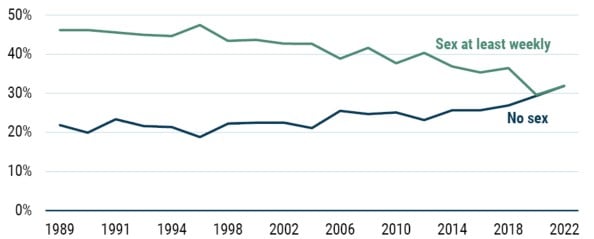
As of 12/31/2022 | Source: General Social Survey
How can we prove all this? Despite many peer-reviewed articles, there is as of yet no academic consensus that chemicals are impairing human fertility, and controlled human experiments cannot ethically be done (although it is clearly the case in laboratory animal experiments). But what we do know for sure is that the quantity of chemicals, PFAS, and nanoplastics messing with our hormones has vastly increased over the last 75 years. This should lead us to expect an impaired ability to have children and lower interest in sex. Thus our apparent free choices may have become chemically influenced and therefore substantially compromised.
Part 2
The Modern Fertility Crisis
Birthrates Are Collapsing
In every country for which halfway-reasonable data exists, children per woman peaked at 6 or more. Those countries that led the Industrial Revolution peaked first and declined the slowest. Exhibit 5 shows 200 years of history of birthrates in the U.S. Exhibit 6 shows the world total fertility rate, which has dropped shockingly fast from its peak of 5.3 children per woman around 1963 to 2.3 today in just 60 years. Exhibit 7 shows the declines in four of the most important economies in the West. Exhibit 8 shows the extremely important cases of China (1.05 children per woman today) and India (2.0 today), which between them have over 35% of our planet’s population. Exhibit 9 shows four of the more remarkable declines, which ended at such low levels that, if maintained for just four generations, these countries will be out of business as effective economies – three of them would be down to 13% of today’s babies, and one, South Korea, would fall to an incomprehensible 1.5%. That means that in South Korea’s future, every eight grandparents will have to share a single grandchild! Try to imagine a society where one grandchild bears that kind of burden. It will surely be impossible to maintain a functioning economy and society.
Take your time. You will now know more than over 99% of the public on this matter that is both weirdly ignored and extremely important and urgent. We – that is, humanity – are running out of time.
Exhibit 5: Total Fertility Rate, U.S.*
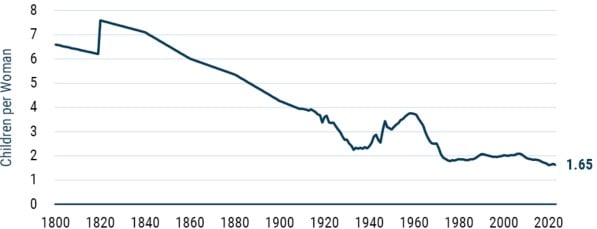
*Approximate data prior to 1950
As of 2023 | Source: Gapminder, UN World Population Prospects
Exhibit 6: Total Fertility Rate, World
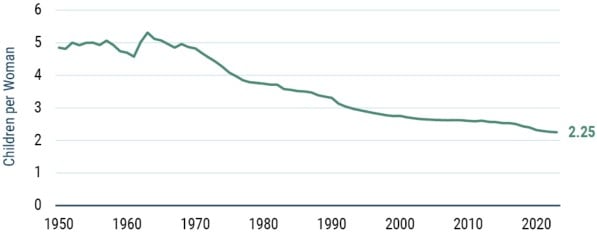
As of 2023 | Source: UN World Population Prospects
Exhibit 7: Total Fertility Rate, Leading Western Economies
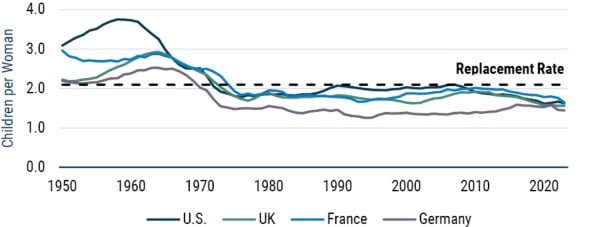
As of 2023 | Source: UN World Population Prospects
Exhibit 8: Total Fertility Rate, China and India
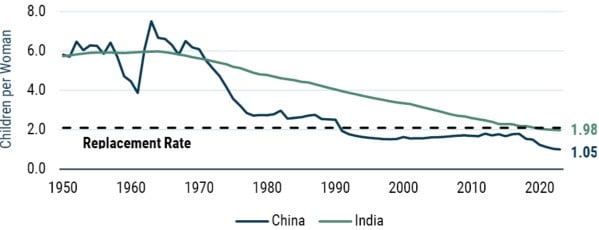
As of 2023 | Source: UN World Population Prospects
Exhibit 9: Total Fertility Rate, Major Low-Fertility Economies
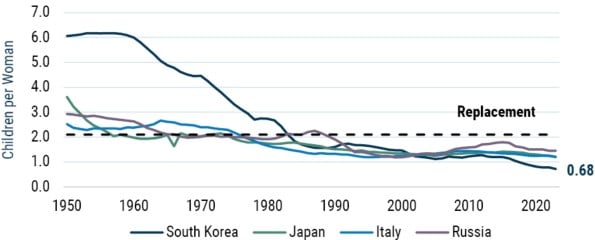
As of 2023 | Source: UN World Population Prospects
It is as if there is no bottom to this decline, which has prompted many different attempts to stimulate births to no sustained effect. If this trend continues, world population is likely to be far lower than the 10 billion+ currently projected by 2100. 6 or 7 billion seems far more likely. If this trend continues further, which also seems very likely, we could be down to only 2 or 3 billion by 2200. Such a rapid decline in births combined with lengthening lifespans will create enormous stresses on economies as the ratio of workers to unproductive retirees falls. (Continued short-run growth of the African population might be something of a safety valve for three or four decades as labor in the developed world goes into extreme shortage and demand for expensive eldercare rises. But taking advantage of this safety valve will depend on healthy global politics – above all, on controlled and sensible immigration policies. In the current political climate, this seems highly uncertain.)
Trying to Understand the Baby Bust
Toxicity is massively underrated, but many of the social and economic factors behind the decline in birth rates are well known. 22 From the beginning of the Industrial Revolution, families in industrializing countries had less need for uneducated farm labor using children. Rapid advances in medical technology meant that far more babies could survive past the first few years of their life, making it less necessary to have high birthrates. Then starting after World War 2, we had the invention of powerful and effective contraception.
Women have now overtaken men in education standards in most rich countries and increasingly compete with men financially and career-wise. But the simple fact that it is women who give birth and are the primary nurturers of children gets in the way of careers and creates a tilted playing field for mothers. Where local cultures are particularly chauvinistic, fertility has fallen fastest, but even in egalitarian countries like Sweden birthrates have fallen significantly in the past 60 years.
Another blow to birthrates is that in the past 40 or 50 years, having children has become increasingly expensive, with the costs of childcare, education, and housing having all risen far above the general rate of inflation. It is also increasingly demanding of time, with the standards and expectations for how much children should be both sheltered and cultivated having risen enormously. Children are not so often expected to look after themselves and are kept more thoroughly scheduled with enriching activities. The effort to develop the most qualified and advantaged children is now so intensive that it routinely causes extreme stress for the parents, particularly the mother, who in even the more enlightened families continues to put in the lion’s share of effort and worry.
The result of the combination of these rising expectations for women to make their mark on the world and the rising cost of children is that even the women who know they want to have children are doing so at a much older age. Women have been deferring childbirth to get more education – in many countries today, including the U.S., women are, for example, credited with over 50% of advanced degrees. Once that’s achieved, they understandably want to get a jump start on their careers, find an ideal (or just satisfactory) mate, and build up the necessary savings. 23 This serial deferral of child-bearing interacts unpleasantly with the biological reality that women are naturally far less fertile after 30 or so, the age at which the modern career woman is just beginning to feel ready to have children. This natural decline in fecundity associated with the postponement of motherhood is further complicated, and perhaps compounded, by the crippling effects of toxicity.
But, as important as these other factors are, it is the relatively new and still underrated problem of toxic damage to both libido and fertility that – on top of an already-long list of hurdles – will guarantee further declines in birth rates, in all likelihood to such an extent that even the most effective measures to address the economic and social factors driving down birth rates will not be enough.
As clear as the data is, there seems to be extraordinarily little interest in this existential threat – a threat that appears, in the cases of falling sperm count, sperm quality, and fertility, to have gone even further and faster into dangerous territory than climate change. Though declining birth rates and their potential demographic impact have begun to garner some attention, most commentators seem to be almost completely unaware that toxicity is a factor. Extensively researched and detailed books have been written on the social, cultural, and economic causes and consequences of the baby bust without a single mention of the direct impact of toxicity! I first wrote about the topic five years ago in “Chemical Toxicity and the Baby Bust,” 24 and in the last year or so there seems to be some growing awareness that microplastics, “forever chemicals,” et al. are already posing risks to our health. We must hope so, for there is desperately little time and some countries, like South Korea, may have already passed the point of no return.
It is worth making the point that there is something like momentum or inertia at work here. When my generation were married in the 60s, and for several generations before that, we did not really think about how many children to have. We all had a couple of children and only then discussed the pros and cons of a third or fourth. The culture was so powerful that it was simply what everybody did (or at least the great majority.) But this still-powerful cultural influence is changing. The default assumption today has become one or no children, and the longer these new forces dominate, the stronger this cultural effect will become. It’s what makes South Korea’s position so difficult: it currently has the most rapidly declining baby cohort, with births falling an astonishing 6% further this year from what was already the world’s lowest fertility rate. A culture of having few if any children appears to be taking a strong hold.
Part 3
Toxicity Brings Other Harms
Health Effects of Toxicity Beyond Fertility
There are a number of otherwise hard-to-explain trends in health across the developed world – from obesity to autism to Parkinson’s to increasing rates of some cancers – where environmental toxicity is very likely a contributing factor. As is well known, obesity rates have exploded globally in the petrochemical era of the last 60 years (see Exhibit 10) and there is conclusive evidence based on controlled experiments in animals that some specific industrial chemical exposures in utero can lead to lifelong weight gain. 25 The autism epidemic – the 200-fold increase in the rate of autism diagnoses in the past 50 years (see Exhibit 12) – is also now widely-remarked upon and still unexplained. While increasing awareness and loosening diagnostic criteria must account for some portion of this increase, building evidence indicates that exposure to environmental toxicants causes neurodevelopmental damage that manifests as autism. 26 Parkinson’s – the world’s fastest growing brain disorder – is now held to be primarily driven by toxic exposures. 27 And while (age-adjusted) cancer rates are generally slowly falling today at about 0.3% a year (mostly as a result of the decline in cigarette smoking), both testicular and breast cancers are rising rapidly (see Exhibit 11.) Rising rates of testicular cancer were a key prediction of the first scientists to raise the alarm about the effects of toxicity on fertility as the in-utero toxic damage that lowers lifetime sperm counts also increases lifetime testicular cancer risk. 28
Exhibit 10: U.S. Obesity Rate
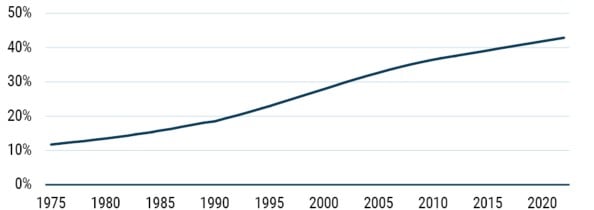
As of 2022 | Source: World Health Organization Global Health Observatory
Exhibit 11: U.S. Testicular Cancer and Breast Cancer Cases per 100,000

As of 2021 | Source: National Cancer Institute Surveillance, Epidemiology, and End Results Program
Exhibit 12: Autism Prevalence in the United States 1970s-2020
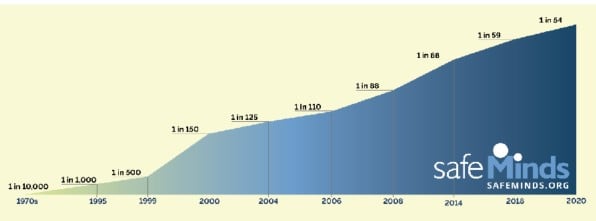
As of 12/31/2020 | Source: SafeMinds
There is no reason to expect an early decline in this rising health damage. Most recently, a shocking paper from the New England Journal of Medicine showed that heart disease patients whose arterial plaques contained nanoplastics had a 4.5 times higher risk of subsequent heart attack, stroke, or death in the next few years than those who did not. 29 It seems all too likely that fertility damage is just the leading edge of the harm done by these substances in our bodies. Other effects guarantee increased ill health and much increased health costs. For one example, a recent study suggests the total cost of plastic-related toxicity to the U.S. healthcare system now amounts to $250 billion annually. 30 Indeed, nanoplastics seem to have a marked affinity for our particularly fatty brains. 31 This can’t be good for our impulse control, general psychological well-being, or indeed, our common or garden general IQ! We should probably reconcile to seeing more wild and apparently irrational behavior all around us, at every level – not a comfortable thought.
Poisoning and Squeezing the Life Out of Nature
The health effects of toxic pollution are of course not limited to humans, but impact all of nature. We can start with insects, quite possibly the single most important component. In the last 50 years alone, we have lost 50% or more of the biomass of all insects (their collective weight), with some estimates as high as 75%. 32 As far as can be measured, the continued loss of insect biomass is around 2% a year, a rate that will halve current numbers in 35 years and divide them by eight in 105 years.
Entomologists are confident that – while climate change and habitat destruction play a role – this decline in insects is very significantly a byproduct of toxicity, unsurprisingly, as swathes of the pesticides that we spray on agricultural land (which then wash into rivers, and come down in rain) are specifically designed to kill these insects. In measuring the consequences of this, given insects are not a naturally sexy nor well-funded field, the best one can do is ask senior experts what they believe. E.O. Wilson (the “Ant Man”), for example, used to say that nature can thrive without humans, but without insects, the current more-or-less-stable workings of our environmental systems would simply unravel. Dung and all other debris would largely stop recycling. Fruits and flowers, both commercial and natural, would not be pollinated. The birds and amphibians dependent on insects would fail, and so on, cascading through the whole system of life.
Amphibians have been hit even harder. In the U.S., their population is said to be declining now at a staggering 3.8% a year 33 – a rate that will reduce their population by 98% in a century. This decline is believed to have started in the 1950s or 1960s – alongside the invention of and dramatic increase in petrochemicals. Amphibians, because they have porous skins, are exceptionally hard hit by pollution and toxic chemicals, and (like sperm counts for men’s health) they are considered a bellwether of ecosystem health. Like with insects, the rapid decline since World War 2 suggests that this explosion in toxic pollutants has dramatic and harmful effects on the health of most living things.
Part 4
The Problematic Interaction of Capitalism and Toxicity
Consequences of the Extreme Power and Short-Term Focus of U.S. Corporatism
The bottom line is surely that either most chemicals and plastics will have to be replaced with alternatives, or we homo sapiens will be replaced. By polluting our environment with toxic chemicals, the usual drive for short-term capitalist efficiency in profit maximization has at least helped to reduce women’s effective interest in having children. It has also helped create a world that is toxic to life in most forms, including ours, and hold effective political pushback on the topic to a truly remarkable minimum. Increasing toxicity may pose an indirect threat to our vitality as a species by undermining the natural world, without which we may not be able to sustain a viable civilization. It simultaneously seems certain to threaten our existence directly through its impact on our health, particularly our fertility. The massive long-term effect will be in the direct loss of consumers and thus the need to manage entire economies to be smaller – a job that not only have we had little practice in doing over the last 200 years, but one that, from our few examples of decaying middle American industrial towns and Japanese countryside villages, we already know to be fiendishly more difficult than managing economies for growth.
The U.S., with its domination of corporate interests and short-term profit, will not be a leader in reducing toxic chemicals and plastics. We will have to rely on more enlightened countries. And here at least we catch a break because toxicity is overwhelmingly local (although as previously mentioned, some small fraction of toxicity is disseminated far and wide via rain and air). The EU is leading the way on toxicity, having banned over 2500 chemicals for use in cosmetics, whereas Canada has banned 573 and the U.S. has banned 11! Not 11 hundred, just 11! We should expect to see real consequences from this difference in behavior, in terms of increasingly better fertility and health for them and worse for us, over the course of this century. Sweden’s life expectancy is already six years greater than that of the U.S., up from just two years in 1980 or indeed 1950. By 2050 the gap will almost certainly be much wider still. If the issue is still largely ignored in the U.S. it will mainly be us in the U.S. paying the price.
I might add that we can in fact do without plastics entirely, given time. With innovation, we may be able to find superior substitutes for plastics, replacing petrochemical plastics with bioplastics, cellulosic fibers, and so on. The potential for future discoveries in bioengineering – most likely, specialized materials constructed by engineered microbes – is even more promising. And we have always had glass, metal, and wood products, which unlike plastics, are fully recyclable and completely non-toxic.
Questions for Capitalism in a Shrinking World
The toxicity issue, given it leads to accelerating declines in fertility around the world, adds another serious wrinkle to our problem of civilization in overshoot. Severe economic consequences from population shrinkage will occur at the same time that our general health worsens, from both the effects of increased toxicity and increased climate damage – especially increased heat, humidity, and pollution from wildfires among many other health effects. It was always going to be the intersection of these different problems, some unexpected, that will downgrade our ability to respond effectively to any of them. Rising toxicity is going to be the worst problem facing our efforts to overcome the ill effects of climate change, as shocks to the economic system from a declining workforce and an inverted population pyramid might well make many of us feel too poor to make the required financial effort.
What are the likely outcomes for capitalism and society from a rapidly falling global population of babies and young workers, and an equally rapid increase in the population of unproductive and old? In the short and intermediate periods, say up to 50 years, none of these likely outcomes are good. Top-line revenues continually shrink. We were only 2.2 billion as recently as my birth, but it is undeniably much harder to manage an economy downward as 40 restaurants in the town become 20 and all 40 suffer in the process, and as highway and rail systems become too big for their boots (as it were). How does one select which parts of the infrastructure to maintain? Ask the city management of Detroit, and they’ll tell you it is a very tough management task indeed.
Although these twin problems of toxicity and falling population may be the biggest shock of modern times to the social and economic fabric, the cure to toxicity, at least, does not require rocket science: it is intellectually straightforward – even simple – merely incredibly difficult to execute in the real world. All we have to do is a) over the next generation or two at most (sixty years) detoxify the planet, which means ending the flow of toxins and allowing time to flush out say 90% of their accumulated total, and b) detoxify capitalism, which unfortunately will be far more difficult, and even if successful, is certain to require several generations. Doing this requires that we remove the currently deadly second and third order effects of mis-specified incentives, which are certain to run us off the cliff unless successfully addressed. That is to say, all the direct and indirect costs associated with production – pollution, toxicity, climate damage, soil erosion, etc. –must be fully internalized. If we continue to let corporations make profits by dumping their costs onto the public, we will very probably fail.
Beyond that, a new set of social incentives are needed to 1) increase the drive for quality of life over quantities of consumption and 2) increase the appeal of family (or community) life and parenthood. In short, we must learn to treat an eventual 2.1% fertility rate as a necessity for long-term sustainability, just as much as clean air and water, and probably well-maintained soil. They are all really our commons. If any one of them fail, we as a species will also fail. So, we must treat the production of healthy children as a group problem: it takes a village, etc. In this case it takes a society. Our social mores and our finances will have to make the necessary changes, none of which are easy. Success is far from certain, for capitalism in its current and particularly extreme form defends quite effectively against attempts to protect nature and our grandchildren. In their current configuration, the extreme capitalists may well win, making – and possibly even increasing – profits right up to the cliff’s edge. Alas, Milton Friedman has done too good a job. But I nevertheless believe that we can still find a way through this minefield to live a sustainable life within an effectively protected natural environment.
Part 5
Investment Implications of Toxicity
No-Brainer and Near-Term, Sell Most Chemicals Companies
Toxicity and its effects – cancers, general ill health, the reduced ability to have children, and even the reduced desire to have children – all caused by chemicals and plastics, seems to me a substantially more personal and potentially more urgent issue than even the dire longer-term threats of climate change, which can feel more abstract (unfortunately, insofar as allowing us to respond more slowly). Our negative response to toxic chemicals, particularly forever chemicals, seems to be gathering force and could quite likely snowball in the coming decade. If it does not, our general health will be in very bad shape indeed. (Remember: sperm count is the best predictor of general health and longevity in men!) We will also be unlikely to have a population profile that would allow for viable economics and politics.
In the very short run, the top of the problem list is of course that chemical companies are likely to be sued even more enthusiastically than oil and gas companies of late. In both cases, they have been caught with their pants down or, rather, their files open: it is clear in several cases that they knew the damage their products would cause 34 and still they withheld that data, furiously contested the facts, or worse yet, designed campaigns to confuse the issue by sowing false doubts. Five years ago in my first toxicity report, I warned of the risk to chemical companies narrowly before Bayer, who had just bought Monsanto, was sued for the apparently cancer-causing active ingredient in Roundup, the most commercially successful herbicide. The net economic consequence of this being that the combined firm is now worth less than Monsanto alone had been prior to the acquisition (and global equity markets are much higher).
Complex and Long-term, Life in the Slow Lane
How does capitalism thrive or even survive a finite world in which growth in physical output must slow, or even reverse, before finally settling into a sustainable world where growth is qualitative and each generation of new products is more practical, better designed, more repairable, more recyclable, and longer lived? The developed world and China will be dealing with a problem for which there is no precedent – a declining workforce and at best a minimal increase in GDP. Managing economies that for decades have been fine-tuned for growth at any price against this new no-to-low growth spin will be difficult, and in the early years, before the penny really drops, it will be outright painful and dangerous.
A major partially mitigating factor for us, however, is that the U.S. will have one of the less-stressed systems due to its substantial immigration. It is calculated that illegal immigrants alone constitute 5% of the U.S. workforce, and as of 2022, 14% of the U.S. population was born abroad – the highest level since the 1910s. 35 (It is worth noting here that in 20 years or less, many other countries will be competing for immigrants. In the countries with the most inverted population pyramids – soon to be 3-4 grandparents per worker as countries hit a fertility rate of 1 – smarter youngsters will emigrate to less bad countries in a self-reinforcing process that will surely cause some governments to try to forbid emigration. What an irony this is in the face of today’s growing political resistance to immigration. Yet reality is a great teacher and thus Japan, at the extreme of long-term distaste for immigration, now begins to change at an accelerating rate.) Added to our relative advantages in fertility, the U.S. and Canada are generously endowed with farmland, water, old-fashioned fossil energy and new-fashioned wind and solar potential, plus many metals and potash. (The only shortage we have that might really matter one day is phosphate.) The U.S. has a third edge, venture capital, which in my opinion is the best part of U.S. capitalism, enhanced as it is by about 15 of the world’s top 20 great research universities, together attracting a steady flow of the best and brightest from around the world.
So how would one invest in this particular slowing global economy? In a word (or two), resilience and sustainability. We must transition to a fully sustainable world and withstand many shocks along the way – shocks that will start to arrive quicker and more painfully than has been the case since World War 2. Indeed, I would argue that these shocks have already begun in climate damage, ill health, and falling fertility in particular. Few seem to really notice how global GDP growth has started to slow (see Exhibit 13) given much of the slowdown in general growth was covered up by China’s astonishing surge (China’s GDP has grown 50x since 1980, an unrepeatable performance).
Exhibit 13: World and World ex-China Real GDP Growth (Rolling 10-Year Average)
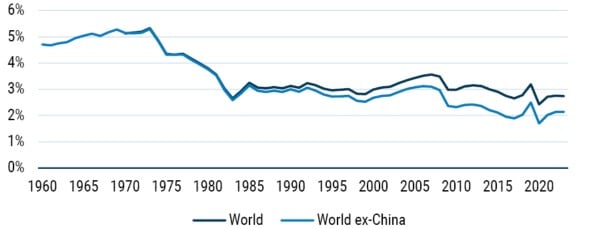
As of 2023 | Source: World Bank, Penn World Table, GMO
There will be a lot of clanking of gears. These recurrent and increasing shocks to GDP, and hence to the stability of society as its members feel increasingly insecure, will mean the value of resilience will steadily increase. The ability to withstand climate shocks, economic shocks, and social instability must all increase. Think about those virtues and vices for every company you invest in, for the need for them will grow more quickly than you think.
But the simplest advice must be to avoid financial leverage (the very opposite of resilience) wherever possible and emphasize the positive resilience of high margins. In a nutshell, look for high-quality stocks with the ability to withstand an increasingly risky world facing more shocks amid which the failure rate of marginal, levered companies will increase. Investing (and living for that matter) will never be the same again! Never again, I believe, will it be as easy as the last 75 years. Yet in the U.S. today, the stock market is priced with one of the highest P/Es in history, as if the next 50 years will be heaven. I wouldn’t hold your breath.
Download article here.
Civilization will face five challenges that are guaranteed to be existential (or nearly so) if not addressed in the next several decades: 1) climate change, 2) resource depletion, 3) biodiversity collapse, 4) deficiencies of capitalism, and 5) toxicity.
Chan, K.K. Jason, and David O'Hagan. 2012. “The Rare Fluorinated Natural Products and Biotechnological Prospects for Fluorine Enzymology,” Methods in Enzymology 516 (Academic Press), chap. 11. DOI: 10.1016/B978-0-12-394291-3.00003-4.
Petkowski, Janusz J., Sara Seager, and William Bains. 2024. “Reasons Why Life on Earth Rarely Makes Fluorine-containing Compounds and Their Implications for the Search for Life Beyond Earth,” Scientific Reports 14, no. 15575. DOI: 10.1038/s41598-024-66265-w.
Coperchini, Francesca, Laura Croce, Gianluca Ricci, et al. 2021. “Thyroid Disrupting Effects of Old and New Generation PFAS,” Frontiers in Endocrinology 11. DOI: 10.3389/fendo.2020.612320.
Gaillard, Lucas, Robert Barouki, Etienne Blanc, Xavier Coumoul, and Karine Andréau. 2024. “Per- and Polyfluoroalkyl Substances as Persistent Pollutants with Metabolic and Endocrine-disrupting Impacts,” Trends in Endocrinology & Metabolism 36, no. 3: 249-261. DOI: 10.1016/j.tem.2024.07.021.
Wang, Yufei and Haifeng Qian. 2021. “Phthalates and Their Impacts on Human Health,” Healthcare 9, no. 5: 603. DOI: 10.3390/healthcare9050603.
Lucaccioni, Laura, Viola Trevisani, Erica Passini et al. 2021. “Perinatal Exposure to Phthalates: From Endocrine to Neurodevelopment Effects,” International Journal of Molecular Sciences 22, no. 8: 4063. DOI: 10.3390/ijms22084063.
Swan, Shanna H. 2008. “Environmental Phthalate Exposure in Relation to Reproductive Outcomes and Other Health Endpoints in Humans,” Environmental Research 108, no. 2: 177-84. DOI: 10.1016/j.envres.2008.08.007.
vom Saal, Frederick S. and Laura N. Vandenberg. 2020. “Update on the Health Effects of Bisphenol A: Overwhelming Evidence of Harm,” Endocrinology162, no. 3. DOI: 10.1210/endocr/bqaa171.
Kawa, Iram Ashaq, Akbar masood, Qudsia Fatima et al. 2021. “Endocrine Disrupting Chemical Bisphenol A and Its Potential Effects on Female Health,” Diabetes & Metabolic Syndrome: Clinical Research & Reviews 15 no. 3: 803-811. DOI: 10.1016/j.dsx.2021.03.031.
Han, Yu, Zhiquan Liu, Liping Lu et al. 2024. “Tetrabromobisphenol A Reduces Male Rats Reproductive Organ Coefficients and Disrupting Sexual Hormone by Causing Oxidative Stress,” Toxicology 505, no. 15387. DOI: 10.1016/j.tox.2024.153837.
Kucka, Marek, Kristina Pogrmic-Majkic, Svetlana Fa, Stanko S. Stojilkovic, and Radmila Kovacevic. 2012. “Atrazine Acts as an Endocrine Disrupter by Inhibiting cAMP-specific Phosphodiesterase-4,” Toxicology and Applied Pharmacology 265, no. 1: 19-26. DOI: 10.1016/j.taap.2012.09.019.
Rahman, Hafiz Ubaid ur, Waqas Asghar, Wahab Nazir et al. 2020. “A Comprehensive Review on Chlorpyrifos Toxicity with Special Reference to Endocrine Disruption: Evidence of Mechanisms, Exposures and Mitigation Strategies,” Science of the Total Environment 755 Pt. 2, no. 142649. DOI: 10.1016/j.scitotenv.2020.142649.
Gea, Marta, Chao Zhang, Roberta Tota, Gianfranco Gilardi, Giovanna Di Nardo, and Tiziana Schilirò. 2022. “Assessment of Five Pesticides as Endocrine-Disrupting Chemicals: Effects on Estrogen Receptors and Aromatase,” International Journal of Environmental Research and Public Health 19, no. 4: 1959. DOI: 10.3390/ijerph19041959.
Mérida, Diana María, Belén Moreno-Franco, Montse Marquès, Montserrat León-Latre, Martín Laclaustra, and Pilar Guallar-Castillón. 2023. “Phthalate Exposure and the Metabolic Syndrome: A Systematic Review and Meta-Analysis,” Environmental Pollution 333: 121957. DOI: 10.1016/j.envpol.2023.121957.
Radke, Elizabeth G., Joseph M. Braun, John D. Meeker, and Glinda S. Cooper. 2018. “Phthalate Exposure and Male Reproductive Outcomes: A Systematic Review of the Human Epidemiological Evidence,” Environmental International 121 Pt. 1: 764-793. DOI: 10.1016/j.envint.2018.07.029.
Braun, Joseph M. 2016. “Early-life Exposure to EDCs: Role in Childhood Obesity and Neurodevelopment,” Nature Reviews Endocrinology 13: 161–173. DOI: 10.1038/nrendo.2016.186.
eBioMedicine. 2023. “Forever Chemicals: The Persistent Effects of Perfluoroalkyl and Polyfluoroalkyl Substances on Human Health,” eBioMedicine 95, no. 104806. DOI: 10.1016/j.ebiom.2023.104806.
Hannas, Bethany R., Johnathan Furr, Christy S. Lambright, Vickie S. Wilson, Paul M. D. Foster, and L. Earl Gray, Jr. 2010. “Dipentyl Phthalate Dosing during Sexual Differentiation Disrupts Fetal Testis Function and Postnatal Development of the Male Sprague-Dawley Rat with Greater Relative Potency than Other Phthalates,” Toxicological Sciences 120, no. 1: 184–93. DOI: 10.1093/toxsci/kfq386.
Meng, Lingxue, Shiheng Gui, Zedong Ouyang, et al. 2023. “Low-dose Bisphenols Exposure Sex – Specifically Induces Neurodevelopmental Toxicity in Juvenile Rats and the Antagonism of EGCG,” Journal of Hazardous Materials 459, no. 132074. DOI: 10.1016/j.jhazmat.2023.132074.
Kermath, Bailey A., Lindsay M. Thompson, Justin R. Jefferson, Mary H. B. Ward, and Andrea C. Gore. 2022. “Transgenerational Effects of Prenatal Endocrine Disruption on Reproductive and Sociosexual Behaviors in Sprague Dawley Male and Female Rats,” Toxics 10, no. 2: 47. DOI: 10.3390/toxics10020047.
Rogers, Rachael E., Shuyi Chai, Andrew J. Pask, and Deidre M. Mattiske. 2023. “Prenatal Exposure to Diethylstilbestrol Has Long-lasting, Transgenerational Impacts on Fertility and Reproductive Development,” Toxicological Sciences 195, no. 1: 53-60. DOI: 10.1093/toxsci/kfad066.
For much more information, several excellent books that are accessible enough to laymen have been written on these topics in recent years. These include Sicker Fatter Poorer by Leonardo Trasande (2019), Count Down by Shanna Swan and Stacey Colino (2021), The Obesogen Effect by Bruce Blumberg and Kristin Loberg (2018), Toxic Cocktail by Barbara Demeneix (2017), and Our Stolen Future by Dianne Dumanoski, John Peterson Myers, and Theo Colborn (1996).
Levine, Hagai, Niels Jørgensen, Anderson Martino-Andrade et al. 2022. “Temporal Trends in Sperm Count: A Systematic Review and Meta-regression Analysis of Samples Collected Globally in the 20th and 21st Centuries,” Human Reproduction Update 29, no. 2: 157-156. DOI: 10.1093/humupd/dmac035.
World Health Organization (WHO). 2023. “1 in 6 People Globally Affected by Infertility: WHO,” News Release, April 4. https://www.who.int/news/item/04-04-2023-1-in-6-people-globally-affected-by-infertility.
Yu, Xiao, Natasha Nassar, Pierpaolo Mastroiacovo et al. 2019. “Hypospadias Prevalence and Trends in International Birth Defect Surveillance Systems, 1980–2010,” European Urology 76, no. 4: 482-490. DOI: 10.1016/j.eururo.2019.06.027.
Jensen, Tina Kold, Rune Jacobsen, Kaare Christensen, Niels Christian Nielsen, and Erik Bostofte. 2009. “Good Semen Quality and Life Expectancy: A Cohort Study of 43,277 Men,” American Journal of Epidemiology 170, no. 5: 559-565. DOI: 10.1093/aje/kwp168.
Rossen, Lauren M., Katherine A. Ahrens, and Amy M. Branum. 2017. “Trends in Risk of Pregnancy Loss Among U.S. Women, 1990–2011,” Paediatric and Perinatal Epidemiology 32, no. 1: 19-29. DOI: 10.1111/ppe.12417.
Chernikoff, Sara. 2024. “The Average Age of First-Time Mothers Continues to Rise,” USA Today, May 18. https://www.usatoday.com/story/news/health/2024/05/18/graphics-show-changing-trend-average-age-parents/73707908007/.
Statistics Netherlands. 2024. “Women in the EU Having First Child Ever Later in Life,” CBS, March 5. https://www.cbs.nl/en-gb/news/2024/18/women-in-the-eu-having-first-child-ever-later-in-life.
Kahl, Kristie L. 2020. “Testosterone Levels Show Steady Decrease Among Young U.S. Men,” Urology Times Journal 48, no. 7, July 3. https://www.urologytimes.com/view/testosterone-levels-show-steady-decrease-among-young-us-men.
Travison, Thomas G., Andre B. Araujo, Susan A. Hall, and John B. McKinlay. 2009. “Temporal Trends in Testosterone Levels and Treatment in Older Men,” Current Opinion in Endocrinology, Diabetes and Obesity 16, no. 3: 211-217. DOI: 10.1097/med.0b013e32832b6348.
Chodick, Gabriel, Shdema Epstein, and Varda Shalev. 2020. “Secular Trends in Testosterone – Findings from a Large State-mandate Care Provider,” Reproductive Biology and Endocrinology 18, no. 19. DOI: 10.1186/s12958-020-00575-2.
Perheentupa, A., J. Mäkinen, T. Laatikainen et al. 2013. “A Cohort Effect on Serum Testosterone Levels in Finnish Men,” European Journal of Endocrinology 168, no. 2: 227-233. DOI: 10.1530/EJE-12-0288.
Ghaznavi, Cyrus, Peter Ueda, Ayako Okuhama, and Haruka Sakamoto. 2023. “Sexual Behaviors among Individuals Aged 20-49 in Japan: Initial Findings from a Quasi-Representative National Survey, 2022,” The Journal of Sex Research 61, no. 1: 9-20. DOI: 10.1080/00224499.2023.2178614.
Ueda, Peter, Catherine H. Mercer, Cyrus Ghaznavi, et al. 2020. “Trends in Frequency of Sexual Activity and Number of Sexual Partners Among Adults Aged 18 to 44 Years in the U.S., 2000-2018,” JAMA Network Open 3, no. 6. DOI: 10.1001/jamanetworkopen.2020.3833.
Wolfinger, Nicholas H. 2023. “Is the Sex Recession Over?” Institute for Family Studies, May 23. https://ifstudies.org/blog/is-the-sex-recession-over.
Kraus, François. 2024. “La ‘Sex Recession’: Les Français Font-ils Moins L’Amour?” IFOP Group, June 2. https://www.ifop.com/publication/la-sex-recession-les-francais-font-ils-moins-lamour/.
de Graaf, Hanneke, Frederiek Schouten, Saskia van Dorsselaer et al. 2024. “Trends and the Gender Gap in the Reporting of Sexual Initiation Among 15-Year-Olds: A Comparison of 33 European Countries,” The Journal of Sex Research: 1-10, DOI: 10.1080/00224499.2023.2297906.
A favorite book on the topic is Empty Planet: The Shock of Global Population Decline, by Darrell Bricker and John Ibbitson, and a recommended YouTube video, if you prefer, is “Birthgap – Childless World Part 1,” Birthgap.org (2022).
Interestingly detailed (but not peer-reviewed) research – see “Birthgap – Childless World Part 1,” – reveals that the profile of how many children women have, once they are mothers, has been largely unchanged for decades. (The percentage of mothers that have four or more children is the same as it was 50 years ago!) What has changed dramatically is the percentage who do not become mothers, which has risen from 10% (or less, depending on the country – in Italy only 1 in 30 women was childless in 1974) to a third or more. Most of these childless women (about 80%) say they started out wanting and expecting children, but it just seemed to get away from them.
Grantham, Jeremy. 2020. “Chemical Toxicity and the Baby Bust: Unexpected Threats to Human Fertility and, Hence, Chemical Companies,” Viewpoints, February 6. https://www.gmo.com/americas/research-library/chemical-toxicity-and-the-baby-bust_viewpoints/.
The tome on this topic is The Obesogen Effect by UCI professor Bruce Blumberg.
Roberts, James R., Erin H. Dawley, and J. Routt Reigart.2018. “Children’s Low-level Pesticide Exposure and Associations with Autism and ADHD: A Review,” Pediatric Research 85: 234-241. DOI: 10.1038/s41390-018-0200-z.
Kalkbrenner, Amy E., Rebecca J. Schmidt, and Annie C. Penlesky. 2014. “Environmental Chemical Exposures and Autism Spectrum Disorders: A Review of the Epidemiological Evidence,” Current Problems in Pediatric and Adolescent Health Care 44, no. 10: 277-318. DOI: 10.1016/j.cppeds.2014.06.001.
Dorsey, E. Ray and Bastiaan R. Bloem. 2024. “Parkinson’s Disease Is Predominantly an Environmental Disease,” Journal of Parkinson’s Disease 14, no. 3:451-465. DOI: 10.3233/JPD-230357.
Skakkebæk, N.E., E. Rajpert-De Meyts, and K.M. Main. 2001. “Testicular Dysgenesis Syndrome: An Increasingly Common Developmental Disorder with Environmental Aspects: Opinion,” Human Reproduction 16, No. 5: 972-978. DOI: 10.1093/humrep/16.5.972.
Marfella, Raffaele, Francesco Prattichizzo, Celestino Sardu et al. 2024. “Microplastics and Nanoplastics in Atheromas and Cardiovascular Events,” The New England Journal of Medicine 390, no. 10: 900-910. DOI: 10.1056/NEJMoa2309822.
Trasande, Leonardo, Roopa Krithivasan, Kevin Park, Vladislav Obsekov, and Michael Belliveau. 2024. “Chemicals Used in Plastic Materials: An Estimate of the Attributable Disease Burden and Costs in the United States,” Journal of the Endocrine Society 8, no. 2. DOI: 10.1210/jendso/bvad163.
Nihart, Alexander J., Marcus A. Garcia, Eliane El Hayek, et al. 2025. “Bioaccumulation of Microplastics in Decedent Human Brains,” Nature Medicine. DOI: 10.1038/s41591-024-03453-1.
Sánchez-Bayo, Francisco, and Kris A.G. Wyckhuys. 2019. “Worldwide Decline of the Entomofauna: A Review of Its Drivers,” Biological Conservation 232: 8-27. DOI: 10.1016/j.biocon.2019.01.020.
U.S. Geological Survey (USGS). 2025. “Why Are Amphibian Populations Declining?” Biology FAQ, last updated February 21. https://www.usgs.gov/faqs/why-are-amphibian-populations-declining.
We now know from their own files back in the 1970s how well-aware chemical companies were of the long-term and cumulative damage that their products wrought.
The Economist. 2024. “America’s Extraordinary Economy Keeps Defying the Pessimists.” March 14.
Azari, Shabnam Shenasi, Virginia Jenkins, Joyce Hahn, and Lauren Medina. 2024. “The Foreign-Born Population in the United States: 2022,” American Community Survey Brief 019 (U.S. Census Bureau). https://www2.census.gov/library/publications/2024/demo/acsbr-019.pdf.
Disclaimer: The views expressed are the views of Jeremy Grantham through the period ending March 2025 and are subject to change at any time based on market and other conditions. This is not an offer or solicitation for the purchase or sale of any security and should not be construed as such. References to specific securities and issuers are for illustrative purposes only and are not intended to be, and should not be interpreted as, recommendations to purchase or sell such securities.
Copyright © 2025 by GMO LLC. All rights reserved.
Civilization will face five challenges that are guaranteed to be existential (or nearly so) if not addressed in the next several decades: 1) climate change, 2) resource depletion, 3) biodiversity collapse, 4) deficiencies of capitalism, and 5) toxicity.
Chan, K.K. Jason, and David O'Hagan. 2012. “The Rare Fluorinated Natural Products and Biotechnological Prospects for Fluorine Enzymology,” Methods in Enzymology 516 (Academic Press), chap. 11. DOI: 10.1016/B978-0-12-394291-3.00003-4.
Petkowski, Janusz J., Sara Seager, and William Bains. 2024. “Reasons Why Life on Earth Rarely Makes Fluorine-containing Compounds and Their Implications for the Search for Life Beyond Earth,” Scientific Reports 14, no. 15575. DOI: 10.1038/s41598-024-66265-w.
Coperchini, Francesca, Laura Croce, Gianluca Ricci, et al. 2021. “Thyroid Disrupting Effects of Old and New Generation PFAS,” Frontiers in Endocrinology 11. DOI: 10.3389/fendo.2020.612320.
Gaillard, Lucas, Robert Barouki, Etienne Blanc, Xavier Coumoul, and Karine Andréau. 2024. “Per- and Polyfluoroalkyl Substances as Persistent Pollutants with Metabolic and Endocrine-disrupting Impacts,” Trends in Endocrinology & Metabolism 36, no. 3: 249-261. DOI: 10.1016/j.tem.2024.07.021.
Wang, Yufei and Haifeng Qian. 2021. “Phthalates and Their Impacts on Human Health,” Healthcare 9, no. 5: 603. DOI: 10.3390/healthcare9050603.
Lucaccioni, Laura, Viola Trevisani, Erica Passini et al. 2021. “Perinatal Exposure to Phthalates: From Endocrine to Neurodevelopment Effects,” International Journal of Molecular Sciences 22, no. 8: 4063. DOI: 10.3390/ijms22084063.
Swan, Shanna H. 2008. “Environmental Phthalate Exposure in Relation to Reproductive Outcomes and Other Health Endpoints in Humans,” Environmental Research 108, no. 2: 177-84. DOI: 10.1016/j.envres.2008.08.007.
vom Saal, Frederick S. and Laura N. Vandenberg. 2020. “Update on the Health Effects of Bisphenol A: Overwhelming Evidence of Harm,” Endocrinology162, no. 3. DOI: 10.1210/endocr/bqaa171.
Kawa, Iram Ashaq, Akbar masood, Qudsia Fatima et al. 2021. “Endocrine Disrupting Chemical Bisphenol A and Its Potential Effects on Female Health,” Diabetes & Metabolic Syndrome: Clinical Research & Reviews 15 no. 3: 803-811. DOI: 10.1016/j.dsx.2021.03.031.
Han, Yu, Zhiquan Liu, Liping Lu et al. 2024. “Tetrabromobisphenol A Reduces Male Rats Reproductive Organ Coefficients and Disrupting Sexual Hormone by Causing Oxidative Stress,” Toxicology 505, no. 15387. DOI: 10.1016/j.tox.2024.153837.
Kucka, Marek, Kristina Pogrmic-Majkic, Svetlana Fa, Stanko S. Stojilkovic, and Radmila Kovacevic. 2012. “Atrazine Acts as an Endocrine Disrupter by Inhibiting cAMP-specific Phosphodiesterase-4,” Toxicology and Applied Pharmacology 265, no. 1: 19-26. DOI: 10.1016/j.taap.2012.09.019.
Rahman, Hafiz Ubaid ur, Waqas Asghar, Wahab Nazir et al. 2020. “A Comprehensive Review on Chlorpyrifos Toxicity with Special Reference to Endocrine Disruption: Evidence of Mechanisms, Exposures and Mitigation Strategies,” Science of the Total Environment 755 Pt. 2, no. 142649. DOI: 10.1016/j.scitotenv.2020.142649.
Gea, Marta, Chao Zhang, Roberta Tota, Gianfranco Gilardi, Giovanna Di Nardo, and Tiziana Schilirò. 2022. “Assessment of Five Pesticides as Endocrine-Disrupting Chemicals: Effects on Estrogen Receptors and Aromatase,” International Journal of Environmental Research and Public Health 19, no. 4: 1959. DOI: 10.3390/ijerph19041959.
Mérida, Diana María, Belén Moreno-Franco, Montse Marquès, Montserrat León-Latre, Martín Laclaustra, and Pilar Guallar-Castillón. 2023. “Phthalate Exposure and the Metabolic Syndrome: A Systematic Review and Meta-Analysis,” Environmental Pollution 333: 121957. DOI: 10.1016/j.envpol.2023.121957.
Radke, Elizabeth G., Joseph M. Braun, John D. Meeker, and Glinda S. Cooper. 2018. “Phthalate Exposure and Male Reproductive Outcomes: A Systematic Review of the Human Epidemiological Evidence,” Environmental International 121 Pt. 1: 764-793. DOI: 10.1016/j.envint.2018.07.029.
Braun, Joseph M. 2016. “Early-life Exposure to EDCs: Role in Childhood Obesity and Neurodevelopment,” Nature Reviews Endocrinology 13: 161–173. DOI: 10.1038/nrendo.2016.186.
eBioMedicine. 2023. “Forever Chemicals: The Persistent Effects of Perfluoroalkyl and Polyfluoroalkyl Substances on Human Health,” eBioMedicine 95, no. 104806. DOI: 10.1016/j.ebiom.2023.104806.
Hannas, Bethany R., Johnathan Furr, Christy S. Lambright, Vickie S. Wilson, Paul M. D. Foster, and L. Earl Gray, Jr. 2010. “Dipentyl Phthalate Dosing during Sexual Differentiation Disrupts Fetal Testis Function and Postnatal Development of the Male Sprague-Dawley Rat with Greater Relative Potency than Other Phthalates,” Toxicological Sciences 120, no. 1: 184–93. DOI: 10.1093/toxsci/kfq386.
Meng, Lingxue, Shiheng Gui, Zedong Ouyang, et al. 2023. “Low-dose Bisphenols Exposure Sex – Specifically Induces Neurodevelopmental Toxicity in Juvenile Rats and the Antagonism of EGCG,” Journal of Hazardous Materials 459, no. 132074. DOI: 10.1016/j.jhazmat.2023.132074.
Kermath, Bailey A., Lindsay M. Thompson, Justin R. Jefferson, Mary H. B. Ward, and Andrea C. Gore. 2022. “Transgenerational Effects of Prenatal Endocrine Disruption on Reproductive and Sociosexual Behaviors in Sprague Dawley Male and Female Rats,” Toxics 10, no. 2: 47. DOI: 10.3390/toxics10020047.
Rogers, Rachael E., Shuyi Chai, Andrew J. Pask, and Deidre M. Mattiske. 2023. “Prenatal Exposure to Diethylstilbestrol Has Long-lasting, Transgenerational Impacts on Fertility and Reproductive Development,” Toxicological Sciences 195, no. 1: 53-60. DOI: 10.1093/toxsci/kfad066.
For much more information, several excellent books that are accessible enough to laymen have been written on these topics in recent years. These include Sicker Fatter Poorer by Leonardo Trasande (2019), Count Down by Shanna Swan and Stacey Colino (2021), The Obesogen Effect by Bruce Blumberg and Kristin Loberg (2018), Toxic Cocktail by Barbara Demeneix (2017), and Our Stolen Future by Dianne Dumanoski, John Peterson Myers, and Theo Colborn (1996).
Levine, Hagai, Niels Jørgensen, Anderson Martino-Andrade et al. 2022. “Temporal Trends in Sperm Count: A Systematic Review and Meta-regression Analysis of Samples Collected Globally in the 20th and 21st Centuries,” Human Reproduction Update 29, no. 2: 157-156. DOI: 10.1093/humupd/dmac035.
World Health Organization (WHO). 2023. “1 in 6 People Globally Affected by Infertility: WHO,” News Release, April 4. https://www.who.int/news/item/04-04-2023-1-in-6-people-globally-affected-by-infertility.
Yu, Xiao, Natasha Nassar, Pierpaolo Mastroiacovo et al. 2019. “Hypospadias Prevalence and Trends in International Birth Defect Surveillance Systems, 1980–2010,” European Urology 76, no. 4: 482-490. DOI: 10.1016/j.eururo.2019.06.027.
Jensen, Tina Kold, Rune Jacobsen, Kaare Christensen, Niels Christian Nielsen, and Erik Bostofte. 2009. “Good Semen Quality and Life Expectancy: A Cohort Study of 43,277 Men,” American Journal of Epidemiology 170, no. 5: 559-565. DOI: 10.1093/aje/kwp168.
Rossen, Lauren M., Katherine A. Ahrens, and Amy M. Branum. 2017. “Trends in Risk of Pregnancy Loss Among U.S. Women, 1990–2011,” Paediatric and Perinatal Epidemiology 32, no. 1: 19-29. DOI: 10.1111/ppe.12417.
Chernikoff, Sara. 2024. “The Average Age of First-Time Mothers Continues to Rise,” USA Today, May 18. https://www.usatoday.com/story/news/health/2024/05/18/graphics-show-changing-trend-average-age-parents/73707908007/.
Statistics Netherlands. 2024. “Women in the EU Having First Child Ever Later in Life,” CBS, March 5. https://www.cbs.nl/en-gb/news/2024/18/women-in-the-eu-having-first-child-ever-later-in-life.
Kahl, Kristie L. 2020. “Testosterone Levels Show Steady Decrease Among Young U.S. Men,” Urology Times Journal 48, no. 7, July 3. https://www.urologytimes.com/view/testosterone-levels-show-steady-decrease-among-young-us-men.
Travison, Thomas G., Andre B. Araujo, Susan A. Hall, and John B. McKinlay. 2009. “Temporal Trends in Testosterone Levels and Treatment in Older Men,” Current Opinion in Endocrinology, Diabetes and Obesity 16, no. 3: 211-217. DOI: 10.1097/med.0b013e32832b6348.
Chodick, Gabriel, Shdema Epstein, and Varda Shalev. 2020. “Secular Trends in Testosterone – Findings from a Large State-mandate Care Provider,” Reproductive Biology and Endocrinology 18, no. 19. DOI: 10.1186/s12958-020-00575-2.
Perheentupa, A., J. Mäkinen, T. Laatikainen et al. 2013. “A Cohort Effect on Serum Testosterone Levels in Finnish Men,” European Journal of Endocrinology 168, no. 2: 227-233. DOI: 10.1530/EJE-12-0288.
Ghaznavi, Cyrus, Peter Ueda, Ayako Okuhama, and Haruka Sakamoto. 2023. “Sexual Behaviors among Individuals Aged 20-49 in Japan: Initial Findings from a Quasi-Representative National Survey, 2022,” The Journal of Sex Research 61, no. 1: 9-20. DOI: 10.1080/00224499.2023.2178614.
Ueda, Peter, Catherine H. Mercer, Cyrus Ghaznavi, et al. 2020. “Trends in Frequency of Sexual Activity and Number of Sexual Partners Among Adults Aged 18 to 44 Years in the U.S., 2000-2018,” JAMA Network Open 3, no. 6. DOI: 10.1001/jamanetworkopen.2020.3833.
Wolfinger, Nicholas H. 2023. “Is the Sex Recession Over?” Institute for Family Studies, May 23. https://ifstudies.org/blog/is-the-sex-recession-over.
Kraus, François. 2024. “La ‘Sex Recession’: Les Français Font-ils Moins L’Amour?” IFOP Group, June 2. https://www.ifop.com/publication/la-sex-recession-les-francais-font-ils-moins-lamour/.
de Graaf, Hanneke, Frederiek Schouten, Saskia van Dorsselaer et al. 2024. “Trends and the Gender Gap in the Reporting of Sexual Initiation Among 15-Year-Olds: A Comparison of 33 European Countries,” The Journal of Sex Research: 1-10, DOI: 10.1080/00224499.2023.2297906.
A favorite book on the topic is Empty Planet: The Shock of Global Population Decline, by Darrell Bricker and John Ibbitson, and a recommended YouTube video, if you prefer, is “Birthgap – Childless World Part 1,” Birthgap.org (2022).
Interestingly detailed (but not peer-reviewed) research – see “Birthgap – Childless World Part 1,” – reveals that the profile of how many children women have, once they are mothers, has been largely unchanged for decades. (The percentage of mothers that have four or more children is the same as it was 50 years ago!) What has changed dramatically is the percentage who do not become mothers, which has risen from 10% (or less, depending on the country – in Italy only 1 in 30 women was childless in 1974) to a third or more. Most of these childless women (about 80%) say they started out wanting and expecting children, but it just seemed to get away from them.
Grantham, Jeremy. 2020. “Chemical Toxicity and the Baby Bust: Unexpected Threats to Human Fertility and, Hence, Chemical Companies,” Viewpoints, February 6. https://www.gmo.com/americas/research-library/chemical-toxicity-and-the-baby-bust_viewpoints/.
The tome on this topic is The Obesogen Effect by UCI professor Bruce Blumberg.
Roberts, James R., Erin H. Dawley, and J. Routt Reigart.2018. “Children’s Low-level Pesticide Exposure and Associations with Autism and ADHD: A Review,” Pediatric Research 85: 234-241. DOI: 10.1038/s41390-018-0200-z.
Kalkbrenner, Amy E., Rebecca J. Schmidt, and Annie C. Penlesky. 2014. “Environmental Chemical Exposures and Autism Spectrum Disorders: A Review of the Epidemiological Evidence,” Current Problems in Pediatric and Adolescent Health Care 44, no. 10: 277-318. DOI: 10.1016/j.cppeds.2014.06.001.
Dorsey, E. Ray and Bastiaan R. Bloem. 2024. “Parkinson’s Disease Is Predominantly an Environmental Disease,” Journal of Parkinson’s Disease 14, no. 3:451-465. DOI: 10.3233/JPD-230357.
Skakkebæk, N.E., E. Rajpert-De Meyts, and K.M. Main. 2001. “Testicular Dysgenesis Syndrome: An Increasingly Common Developmental Disorder with Environmental Aspects: Opinion,” Human Reproduction 16, No. 5: 972-978. DOI: 10.1093/humrep/16.5.972.
Marfella, Raffaele, Francesco Prattichizzo, Celestino Sardu et al. 2024. “Microplastics and Nanoplastics in Atheromas and Cardiovascular Events,” The New England Journal of Medicine 390, no. 10: 900-910. DOI: 10.1056/NEJMoa2309822.
Trasande, Leonardo, Roopa Krithivasan, Kevin Park, Vladislav Obsekov, and Michael Belliveau. 2024. “Chemicals Used in Plastic Materials: An Estimate of the Attributable Disease Burden and Costs in the United States,” Journal of the Endocrine Society 8, no. 2. DOI: 10.1210/jendso/bvad163.
Nihart, Alexander J., Marcus A. Garcia, Eliane El Hayek, et al. 2025. “Bioaccumulation of Microplastics in Decedent Human Brains,” Nature Medicine. DOI: 10.1038/s41591-024-03453-1.
Sánchez-Bayo, Francisco, and Kris A.G. Wyckhuys. 2019. “Worldwide Decline of the Entomofauna: A Review of Its Drivers,” Biological Conservation 232: 8-27. DOI: 10.1016/j.biocon.2019.01.020.
U.S. Geological Survey (USGS). 2025. “Why Are Amphibian Populations Declining?” Biology FAQ, last updated February 21. https://www.usgs.gov/faqs/why-are-amphibian-populations-declining.
We now know from their own files back in the 1970s how well-aware chemical companies were of the long-term and cumulative damage that their products wrought.
The Economist. 2024. “America’s Extraordinary Economy Keeps Defying the Pessimists.” March 14.
Azari, Shabnam Shenasi, Virginia Jenkins, Joyce Hahn, and Lauren Medina. 2024. “The Foreign-Born Population in the United States: 2022,” American Community Survey Brief 019 (U.S. Census Bureau). https://www2.census.gov/library/publications/2024/demo/acsbr-019.pdf.

